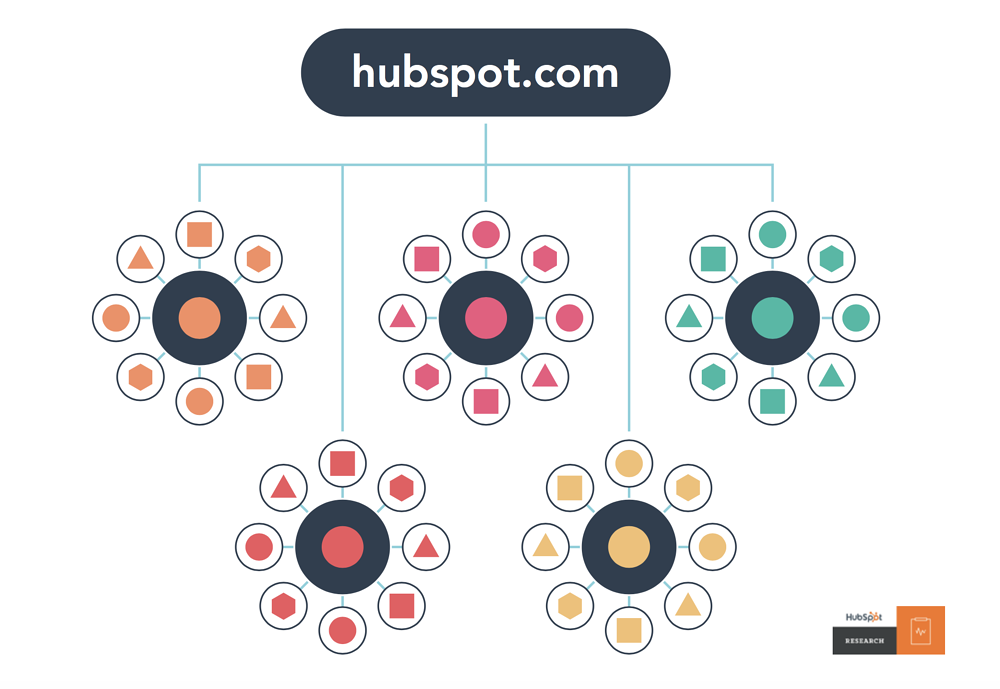Picking topic clusters is a big commitment.
For a marketer, it's the equivalent of getting engaged. Sure, you can call it off, but you might not get the ring back.
When you decide to change your topic clusters, you're preparing to work through the painful process of resetting your work. And while it's possible, why go through the heartache?
We'll show you how to choose the right topic clusters up front so you won't have to worry about whether you made the best choice.
Finding the Right Topic Clusters
Topic clusters are the best way for search engines to link the relevance of your site to the keywords you're targeting. That link lets Google present more accurate results based on the user's intent.
So, to have your page earn the top spot on SERPs, you need to focus on the right topic clusters, and we'll show you how.
1. Brainstorm Your Topics
The first step in choosing the right topic clusters is making a list of what's relevant to your brand. To start, list the core concepts your company is based on or the problems your brand can address.
At this stage, don't think in terms of keyword search volume. Think about the topic's relevance to your audience. The keyword research will come after.
For example, a home restoration company may choose topics like "Water Damage" or "Disaster Mitigation." These are fundamental concepts that their audience is looking for and both hold potential for a wide range of topics within them.
After you've created a list of potential topic clusters, start running them through a research platform like Hubspot's Strategy Tool. This service requires you to input your topics to receive feedback on the monthly search volume.
When deciding on the total number of clusters, select enough that you cover the priority topics, but not so much that you can't provide adequate attention to each.
2. Pick Your Pillars
A pillar page covers everything your topics will expand on in a single page. They focus on generalized terms that you can dive deeper into with your subtopics. These pages will link to all your subtopics, which will link back in return.
Your pillar has a direct correlation to your topic cluster and should be designed as a comprehensive page on the theme. For example, Hubspot uses this pillar page to offer an ultimate guide of sorts, providing information on the topic of productivity.
The pillar needs to be tight enough that it focuses on a single concept, but broad enough that you're not limiting the amount of content you can produce within the topic.
3. Research Your Subtopic Keywords
Once you have the pillars you're planning to target, it's time to come up with an initial list of subtopic keywords. These can vary in many directions, so long as they're tied to the pillar page within the topic cluster.
Your list should be thorough and inclusive. Leave nothing on the table.
If your topic cluster is "commercial real estate," your keywords could be "property tax" or "urban land projects." They don't need a common keyword, but the core concept links them.
Hubspot's tool is designed specifically for topic clusters, so you're able to input your potential list of subtopic keywords and pull the monthly search volume, as well as a relevancy score. While HubSpot's SEO functionality is fantastic for organizing topic clusters, SEMRush is the best keyword research tool for granular keyword analysis.
You're looking for keywords that have a high search volume and low difficulty score. Ranking these in order will give you an idea of which keywords are worth your time. Be sure your domain authority is capable of ranking before attempting something difficult to capture.
4. Fill In Your Subtopic Titles
Now that you have the keywords established, it's time to generate some blog post ideas that can rank for them.
Before hammering out what you think sounds good, consider what the reader is actually looking for. With customer-centric marketing, you're nurturing the customer through the buyer's journey, offering them value along the way. To do this, you need to have content specifically for each stage of their purchase that addresses their needs.
So, from our real estate example earlier, subtopics could be "Are You Overpaying Your Property Tax?" or "X Risks of Urban Land Projects." You can create multiple pieces of content under the same keywords, so long as the overall topic fits the cluster.
Ideally, you'd want to turn your keywords into long tail keywords for each subtopic. So "urban land projects" could turn into "risks of..." or "benefits of..." to capture more specific searches.
Remember, although topics and search intent are critical to SERPs, keywords are still essential to achieve rankings for specific terms.
Using Your Clusters
Topic clusters are the way ahead for your Inbound marketing strategy, but it doesn't need to be difficult to adjust.
Hubspot's Strategy Tool provides a relevancy score based on how much content you have in a specific topic. It also shows your inbound links, so you can be sure you've created the right network of content within your topic. This makes it even easier for you to find and create the best clusters for your company.
If you want more advice on improving your Inbound marketing strategy, check out our free eBook. Conquering the Inbound Marketing Mountain is our guide to goal setting, detailing personas, developing an editorial calendar, and more.






